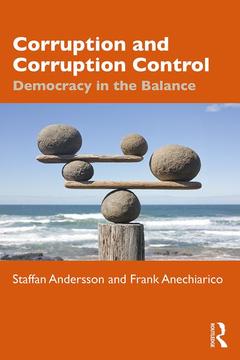Corruption and Corruption Control Democracy in the Balance
Auteurs : Andersson Staffan, Anechiarico Frank

Corruption in politics and public administration is pervasive and difficult to eliminate. It has a strong effect on public attitudes toward government and is at the same time badly understood. A clear, comprehensive understanding of corruption is critical to the goal of ethical government that is trusted by the public.
In this short and accessible text, Staffan Andersson and Frank Anechiarico demonstrate how the dynamics of life in organizations both generate corruption and make it difficult to prevent without undermining the effectiveness of government. They argue that how we define corruption, how we measure it, and how we try to combat it are strongly interrelated and should not be seen as separate issues. The authors demonstrate how this integrated approach, together with a focus on the damage caused by corruption to civic inclusivity and participation, can serve as an entry point for understanding the quality of democracy and the challenge of good governance.
Using examples from mainly the United States and Sweden, Andersson and Anechiarico establish that recent anti-corruption reforms in public administration have often been narrowly focused on bribery (exchange corruption) and law enforcement approaches, while doing too little to other problems and forms of corruption, such as interest conflict.
Corruption and Corruption Control: Democracy in the Balance will be of great interest to all students of politics, public administration and management, and ethics.
1. Democratic Governance, Corruption and Corruption Control 2. What Corruption was, is, and is not 3. Can We Know How Much Corruption There Is? On the Measurement of Corruption 4. Corruption Control in Public Administration 5. The Connection between Public Integrity and Democratic Governance: Four Case Studies 6. Is Corruption Inevitable? Can it be Controlled? 7. The Future of Public Integrity
Staffan Andersson is Associate Professor of Political Science at Linnaeus University, Sweden. His research and teaching focus on public administration and comparative politics. Andersson has published widely on issues of risk vulnerability in public organizations and the measurement of corruption in journals including Political Studies and Public Integrity. He was the principal investigator for the National Integrity System Assessment of Sweden (2012).
Frank Anechiarico is the Maynard-Knox Professor of Government and Law at Hamilton College. He is editor and co-author of Legal but Corrupt: A New Perspective on Public Ethics, co-author with James Jacobs of The Pursuit of Absolute Integrity: How Corruption Control Makes Government Ineffective, and author of articles in Public Administration Review, Urban Affairs Quarterly, Administration and Society, and other journals.
Date de parution : 05-2019
15.2x22.9 cm
Date de parution : 05-2019
15.2x22.9 cm
Thème de Corruption and Corruption Control :
Mots-clés :
Young Men; UK Bribery Act; Frank Anechiarico; NYC Department; Staffan Andersson; Public Integrity; Public Administration; Corruption; Supreme Audit Institution; Political Corruption; Broad Scale Factors; Ethics; Good Life; Exchange Corruption; Government; World Bank Worldwide Governance Indicators; Governance; Corruption Control; Swedish Politics; Street Level Law Enforcement; American Politics; Juvenile Law Center; Public Management; Pruitt Igoe Public Housing Project; democratic governance; Ti’s CPI; law enforcement approaches; Luzerne County; bribery; Corruption Measurement; anti-corruption reforms; Swedish Tax Agency; Ethics Management Strategies; Dagens Nyheter; Individual Public Servant; Irish Catholic Church; Juvenile Justice; Youth Detention Centers; UNCAC



